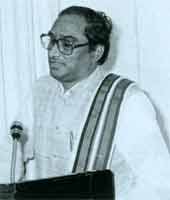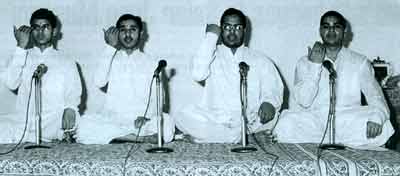

Veda Path

Saluting the Guru: Kala Kosa Day
ARTICLE – The Kala Kosa Division of IGNCA was founded on the Guru Purnima day. Annually, this day is celebrated as Kala Kosa day. This year, the day fell on July 28. The ved path was rendered by students of Veda Vidyapeeth. This was followed by the invocation to Guru through melodious musix by Mrs. Mita Pandit.
The chief guest of the function was Dr. Kutumb Shastri. He began his address by asking as to what India would have been without Vyasa and Valmiki. He said generations of Indians are indebted to the great acharyas who lived and bequeathed to us the great treasures of knowledge.
The only way we can repay the debt is to remember them. Guru purnima is the day when we remember our great teachers, he said. The day is also the sankalp day, for doing penance or taking up anything new academically. Seeking to distinguish between the categories of teachers, he said upadhyayas are teachers who give education in return for a fee, adhyapakas are teachers who may or may not take payment and an acharya has to understand and follow the dharma he is imparting to students. Guru is above all these. In a true sense he is not a teacher, but the person who initiates the student spiritually. Vyasa was such a Guru, he said.
Prof. N.R. Shetty, Member Secretary IGNCA in his address congratulated the Division for the good work done during the preceding year. He said we should strive and bring out better publications. In this context he also urged the scholars to find out the need of the end-users of the books. He said the position of IGNCA as an international Centre for excellence must be enhanced by all the scholars of the Centre. Such a vow, to contribute their best to the institution, must be taken by scholars on Guru Purnima day, he said. As a matter of policy the Centre encourages scholars to under take projects, he added.
Dr. Lalit M. Gujral, Hony. Advisor, made a presentation regarding Kalakosa Programme III-the Kalasamalocana Series. He briefly explained that this programme relates to publications on critical writings on different facets of Arts and Aesthetics.
This year three publications have been brought out in this series. They are: 1. A Bibliography of Ananda Kentish Coomaraswamy, compiled by Mr. James Crouch, 2. The Iconography of the Brahadiswara Templeby Late Madame Francoise L’Hernault, Edited by Dr. Lalit M. Gujral, and 3. The Iconography of the Avalokitesvara in Mainland South-East Asia by Dr. Nandana Chutiwongs. A Reprint of Stupa and its Technology:A Tibeto Buddhist Perspective by Pema Dorjee was brought out, as the first edition had gone out of print.
Dr. Gujral informed that a few more books were in very advanced stages of printing and were likely to be published in the next two months. The titles of books are: 1. the Stylistic of Buddhist Art in India, by Prof. Mireille Benisti, Edited by Prof. Pierre-Sylvain Filliozat; and 2. Indian Narratology by Prof. Ayyapa Panikar. Taking up the programme of bringing out re-organised, thematically arranged volumes with the author’s authentic revisions and edited by eminent scholars in the Collected Works of Dr. Ananda K. Coomaraswamy, he said that till date 14 titles have been published.
The following three books are in advanced stages of publication: Essays in Jaina Art, Edited by Dr. Richard Cohen; Elements of Buddhist Iconography, Edited by Mr. Krishna Deva; and Essays on Music, Edited by Dr. Prem Lata Sharma. In the Selected Letters Series, the press copy of the volume entitled Hazari Prasad Dwivedi Ke Patra, Edited by Shri Narayan Dutt, has been assigned for co-publication.
Dr. Gujral also said several titles in the Collected Works of Ananda K Coomaraswamy series would be taken up next year. Considerable material has been collected for these. Among these are two books, which have not been published during the author’s lifetime and the manuscripts were discovered later by his son Dr. Rama P. Coomaraswamy. They are: Concerning Sphinexes and The Early Inconography of Sagittarius.
IN VARANASI
The Kala Kosa Office in Varanasi celebrated the day with an interesting, scholastic and thought-provoking lecture on `Importance of Guru: an Upanisadic Approach’. Prof. R.C. Sharma, Hony. coordinator of the Centre delivered a speech on the importance of Guru as reflected in the narrative of Indra, Virocana and Prajapati in the Chandogyopanisad.
With a keen interest to attain the Highest Knowledge, Indra and Virocana approached Prajapati and sought instructions from him. Prof. Sharma narrated in a lucid style, how Prajapati imparted the Highest Knowledge to Indra in four installments. Competence of Prajapati as an affectionate Guru and the tenacity and sincerity of Indra in observing celibacy during the 101 years of instruction are both to be admired. With immense perseverance Indra attained Self-Realisation under the teachings of the Guru.
Pt. H.N. Chakravarty, former Chief Pandit of this branch office delivered a brief speech on the importance of Guru in the Tantric Literature.
The programme began with the mangalacharan by Dr. Parvati Bannerjee. Dr. Sukumar Chattopadhyaya gave the welcome address and a brief report of the work done in the office in the preceding year. The vote of thanks was proposed by Dr. Pranati Ghosal. Dr. N.C. Panda compered the programme.
[ Newsletter | List of Newsletter ]




